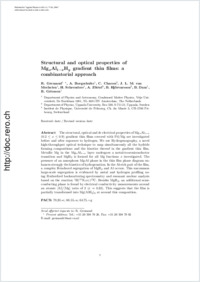Structural and optical properties of MgxAl1-xHy gradient thin films: a combinatorial approach
- Gremaud, Robin Department of Physics and Astronomy, Condensed Matter Physics, Vrije Universiteit, Amsterdam, The Netherlands
- Borgschulte, A. Department of Physics and Astronomy, Condensed Matter Physics, Vrije Universiteit, Amsterdam, The Netherlands
- Chacon, C. Department of Physics, Uppsala University, Sweden
- Mechelen, J. L. M. van Department of Physics and Astronomy, Condensed Matter Physics, Vrije Universiteit, Amsterdam, The Netherlands
- Schreuders, H. Department of Physics and Astronomy, Condensed Matter Physics, Vrije Universiteit, Amsterdam, The Netherlands
- Züttel, Andreas Institut de Physique, Université de Fribourg, Switzerland
- Hjörvarsson, B. Department of Physics, Uppsala University, Sweden
- Dam, B. Department of Physics and Astronomy, Condensed Matter Physics, Vrije Universiteit, Amsterdam, The Netherlands
- Griessen, R. Department of Physics and Astronomy, Condensed Matter Physics, Vrije Universiteit, Amsterdam, The Netherlands
-
2006
Published in:
- Applied Physics A. - 2006, vol. 84, no. 1-2, p. 77-85
English
The structural, optical and dc electrical properties of MgxAl1-x (0.2≤x≤0.9) gradient thin films covered with Pd/Mg are investigated before and after exposure to hydrogen. We use hydrogenography, a novel high-throughput optical technique, to map simultaneously all the hydride forming compositions and the kinetics thereof in the gradient thin film. Metallic Mg in the MgxAl1-x layer undergoes a metal-to-semiconductor transition and MgH₂ is formed for all Mg fractions x investigated. The presence of an amorphous Mg-Al phase in the thin film phase diagram enhances strongly the kinetics of hydrogenation. In the Al-rich part of the film, a complex H-induced segregation of MgH₂ and Al occurs. This uncommon large-scale segregation is evidenced by metal and hydrogen profiling using Rutherford backscattering spectrometry and resonant nuclear analysis based on the reaction ¹H(¹⁵N,αγ)¹²C. Besides MgH₂, an additional semiconducting phase is found by electrical conductivity measurements around an atomic [Al]/[Mg] ratio of 2 (x=0.33). This suggests that the film is partially transformed into Mg(AlH₄)₂ at around this composition.
- Faculty
- Faculté des sciences et de médecine
- Department
- Département de Physique
- Language
-
- English
- Classification
- Physics
- License
-
License undefined
- Identifiers
-
- RERO DOC 5780
- DOI 10.1007/s00339-006-3579-z
- Persistent URL
- https://folia.unifr.ch/unifr/documents/299964
Statistics
Document views: 128
File downloads:
- Texte intégral: 331
